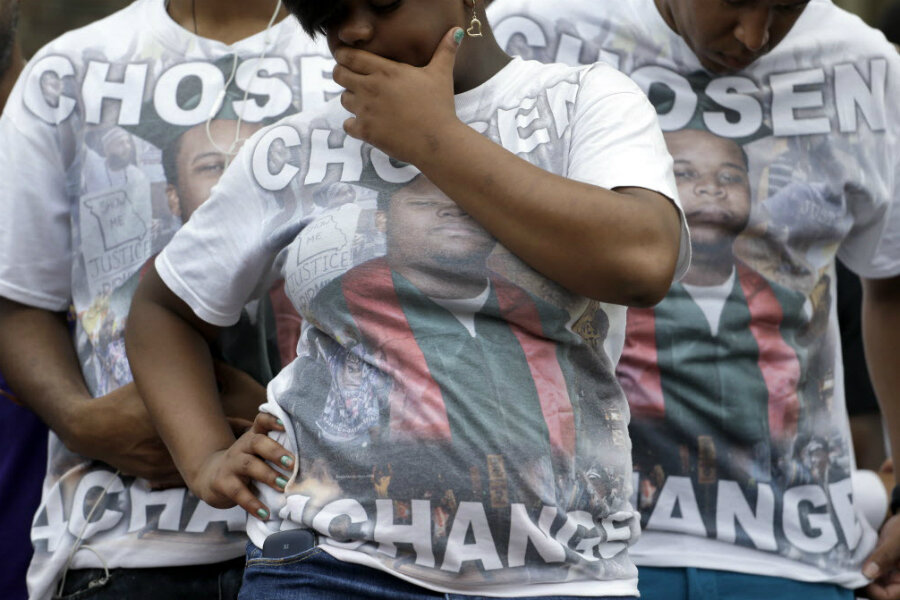How police and a new generation of activists eased Ferguson tension
Loading...
For the first time this week, Ferguson had a night without any arrests Tuesday.
A year after Michael Brown’s death at the hands of a police officer, violence escalated Sunday night, leading to county police declaring a preemptive state of emergency in the city. On Tuesday, a heavy police presence outnumbered a group of around 100 demonstrators, who marched down West Florissant Avenue in Ferguson, a street near where Mr. Brown was shot by former officer Darren Wilson.
For Justin Hansford, a professor at the St. Louis University School of Law, the images of protesters clashing with police, at first blush, were evocatively familiar.
“There was tear gassing on the very spot where Mike Brown was killed … exactly a year later,” he says. “That seems to attest that lessons weren’t learned.”
But beyond those images lies a tumultuous year of change for both groups, and lessons – some still being learned – that have nationwide implications.
The protest movement that erupted in outrage on West Florissant Avenue last August, in the year since Brown's death has grown into a national movement that Professor Hansford and others have called the next generation of the civil rights movement. The police, meanwhile, who have a new chief and a new mandate for reform after a blistering Justice Department report came out in March, won praise from at least some observers for acting with restraint and employing de-escalation techniques during anniversary events.
For Hansford, the most noticeable changes have been in the development of a new generation of activists.
“It was really moving for me to see everybody,” says Hansford, who was in Ferguson this time last year and flew back from South Africa, where he is working as a Fulbright Scholar, to join demonstrations there this year.
“I was out here from Day 1, and to see everybody a year later, so many of them have really grown and developed,” he says. “People who were just anonymous young 20-somethings [last year],” he adds, “a year later they’re regular activists doing work for structural change.”
Speaking to The Monitor earlier this week Brendan Roediger, a professor at St. Louis University School of Law who was in Ferguson on Sunday, said that night would have been "a hundred times worse" if organizers hadn't worked to calm protesters.
Meanwhile, county police officials say the lessons they’ve learned from how protests in the city were handled last year resulted in more peaceful actions this year.
St. Louis County Police Chief Jon Belmar, who is leading a coalition of law enforcement agencies in Ferguson, told the Associated Press that de-escalation tactics taught over the past year were used during the events of the anniversary weekend.
“It comes back to experience,” he said. “We look at it as we’ve seen it before.”
Hansford also praised how police handled protests in Ferguson this year. He singled out Chief Belmar, compared with Thomas Jackson, who was the police chief in Ferguson during last year’s protests. Mr. Jackson stepped down in March amid widespread criticism of the department from both the community and the US Justice Department.
Hansford says he’s been in meetings with Belmar and has come away impressed.
“I think he’s given a lot of thought to how [police] can do better in that situation, how they can have everyone on the same page,” he says “He’s someone who I think genuinely wants to be someone who keeps this region in the position where it’s peaceful and flourishing.”
Jackson is one of a number of changes in the upper echelons of power in Ferguson since Brown’s shooting last year. The city has an interim police chief and an interim judge overseeing reforms to the municipal court. New faces, even if in positions of authority, however, won't be enough, by itself, to effect change.
While some local residents have described improvements in police behavior in the city, there remain systemic racial disparities. The police department is still overwhelmingly white and struggling to recruit minority officers; the region’s housing patterns are also still starkly segregated, according to a New York Times report.
Hansford says that a year ago he supported what he calls “technocratic reforms” to solve issues in Ferguson – things like an increased use of police body cameras, more emphasis on community policing, and increased oversight of city governance. Now he says he doesn’t.
“It doesn’t matter how many cameras you have, doesn’t matter how many reforms you have. We keep having the same problems,” he says. “Instead of thinking of it as something that can be fixed over year or two with policy changes, it’s going to take longer than that. It’s going to be a long battle.”
And he says that a new generation of young activists is poised to lead that battle. A year ago, he says, protests in Ferguson were more unorganized and decentralized. “People were out there on their own,” he says. “They were self-motivated.”
In contrast, demonstrations this year have been much more organized, he says, led by young activists at the head of formal, organized groups, such as #BlackLivesMatter. Their actions, he believes, have kept momentum behind the movement that was launched after Brown’s death.
“If Ferguson had been something started by the NAACP or the Urban League … if it happened that way, I don’t think we would’ve gotten the same response” around the country, he says. “I don’t think it would’ve been as good a movement if it had been led by the old guard.”






